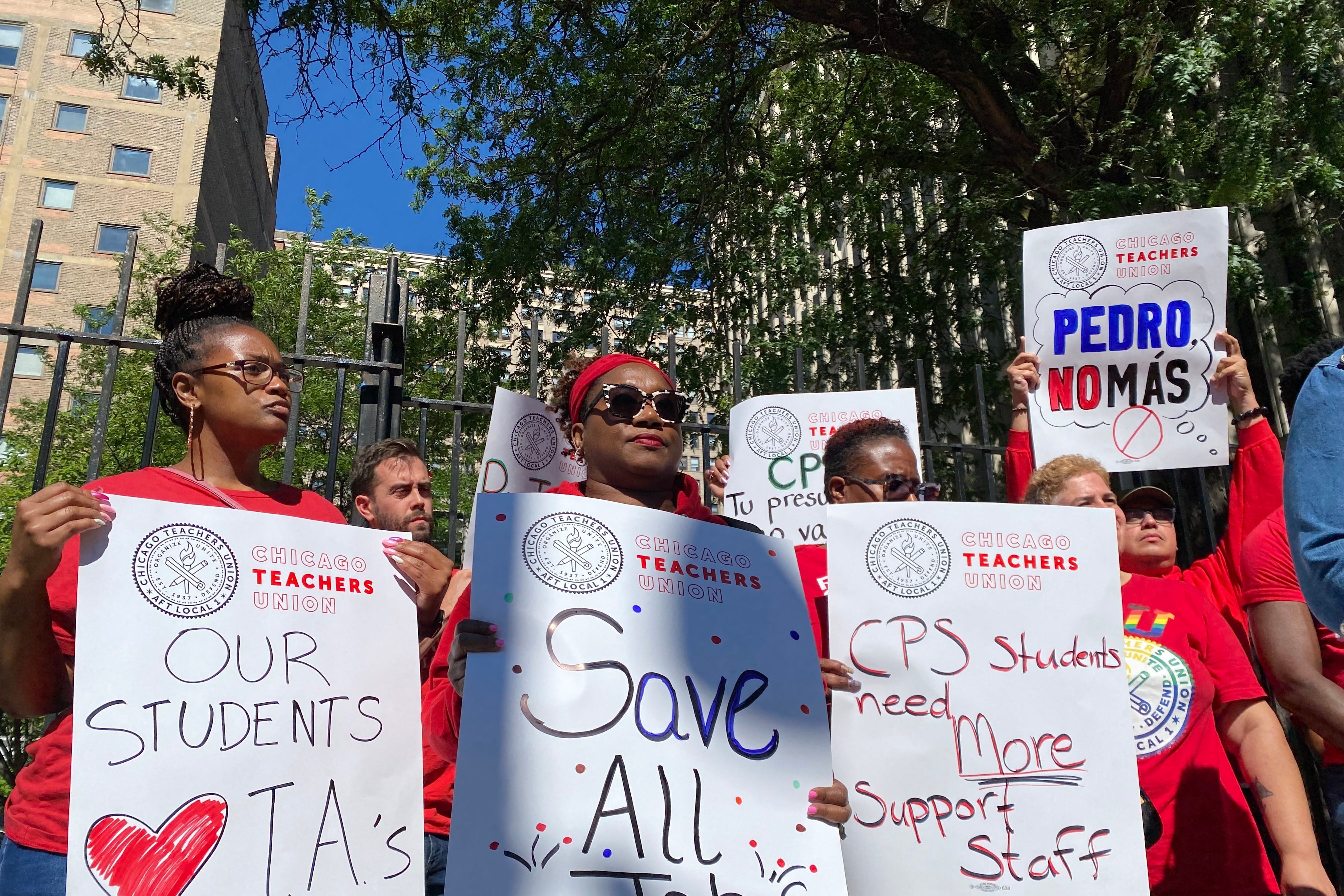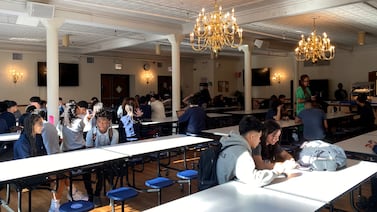Sign up for Chalkbeat Chicago’s free daily newsletter to keep up with the latest education news.
Facing a murkier financial outlook and a budget deficit, Chicago Public Schools has launched “layoff prevention pools” that will guarantee displaced employees positions at other schools — and pay through the next school year.
The district said approximately 600 staffers lost their positions earlier this month. This year, it extended the layoff safeguards — previously in place for teachers — to teaching assistants and other support staff as well. The Chicago Teachers Union held a press conference Thursday to decry at least 330 layoffs of its members, which leaders said disrupt key relationships they build with students and leaves staff in limbo over the summer.
The summer shuffling of staff is a common practice, as student enrollment fluctuates on some campuses. But this year it comes amid a change to the district’s funding formula and as CPS officials have delayed releasing a full budget proposal until July, even though the fiscal year ends this week. Typically, the Chicago Board of Education votes on its annual budget in June.
Instead at their regular meeting Thursday, school board members got an earful from CTU members, as well as some assurance from district officials that school-level funding will stay stable despite an almost $400 million deficit as federal COVID recovery money runs out.
District CEO Pedro Martinez told board members his team needed more time to do due diligence and communicate about the new funding approach, which provides key staff positions to all campuses and uses their level of need to allocate additional dollars.
“There’s no denying that CPS is facing a challenging financial outlook,” Martinez said. “But I remain confident that when our 2024-25 budget is complete, the overall level of funding provided to schools will be maintained or likely increase from what we experienced compared to the last school year.”
The district, which has added thousands of new positions to its payroll in recent years, said it will maintain roughly $500 million in funding increases for schools made since the 2021-22 school year. It stressed that overall, schools will employ more people in the fall compared with this past school year, including 500 more teachers, 600 additional special education paraprofessional positions, and almost 90 more restorative justice coordinators. The district has more than 39,000 employees.
The union said it received a list of laid-off members earlier this week.
Union leaders said most would likely be rehired at other schools, but they argued that the district can do more to avert uncertainty for its employees and disruption to school communities when educators who have bonded with students are reassigned over the summer.
Grisel Sanchez has been working as a bilingual teacher assistant for the past two years at Mark Twain Elementary, supporting and translating for students in kindergarten through eighth grade.
“I translated almost every assignment that was given to (eighth graders) to make it easier for them to understand the material so they could pass their class and graduate,” Sanchez said during the CTU press conference.
On June 7, however, Sanchez said she was called into the office and told her position was being cut and that she could apply for jobs at other schools.
Edward Ward was laid off as a restorative justice coordinator at Sherman School of Excellence this month. He was also let go last year from Beidler Elementary from a similar role. The repeated layoffs, he said, are damaging to the relationship building that a restorative justice coordinator does.
“We are not disposable, and you’ve made a huge mistake to cut those positions, because at the end of the day, it’s our students who suffer,” Ward said.
The district, which has added thousands of new positions to its payroll in recent years, said it will maintain roughly $500 million in funding increases for schools made since the 2021-22 school year. It stressed that overall, schools will employ more people in the fall compared with this past school year, including 500 more teachers, 600 additional special education paraprofessional positions, and almost 90 restorative justice coordinators.
Officials said the district adjusted support staffing to reflect enrollment changes. About 300 of the 595 employees affected are teaching assistants, representing a 0.5% reduction of all employees.
“The district is committed to guaranteeing a job for any of the impacted teaching assistants, and historical data confirms that those who choose to remain in the district will have employment within the district,” Chicago Public Schools said in a statement.
The statement said the district worked closely with the CTU and the SEIU, the union that represents some district support staff, on this effort to ensure laid-off staffers are assigned vacant roles before the start of next school year.
“This assertive initiative is crucial for sustaining our educational gains and providing much-needed school stability,” the district said.
The board approved a resolution Thursday that would allow principals to dip into 2024-25 funds in July ahead of the full budget’s approval so they can line up staff and other resources for the fall.
The layoffs of around 20 restorative justice coordinators comes as the district is overhauling its approach to school safety in a way that centers restorative justice and reduces punitive discipline.
“You can’t say that we are going to move in a direction that honors and respects the humanity of our young people and cut 20 restorative justice coordinators,” said Stacy Davis Gates. “Those two things do not match.”
Addressing the school board, teachers union vice president Jackson Potter said the district has made some headway in addressing disruption from the summer reshuffling of employees — but needs to do more.
“This has now become an annual bloodletting ritual that we hope will end or at least become more humane and thoughtful,” he said.
Potter and educators who addressed the board to protest the layoffs took aim at the district’s Skyline curriculum — an in-house $135 million curriculum the district developed during the pandemic. He argued that the district should use some of the money it spends on rolling out the curriculum to ward off support staff layoffs.
“You should ask people, ‘Do you prefer a TA, or do you prefer this curriculum?’” Potter asked, adding that teachers have called Skyline “a dumpster fire.”
But district officials insisted later in the meeting that school teams led by principals voluntarily adopt Skyline, and they said it has been key to a push to roll out high-quality curriculums in all schools. They said 462 schools have chosen to use Skyline in at least one subject.
“While Skyline might not be a perfect system,” said chief education officer Bogdana Chkoumbova, “it’s definitely a system worth iterating and investing in.”
Mila Koumpilova is Chalkbeat Chicago’s senior reporter covering Chicago Public Schools. Contact Mila at mkoumpilova@chalkbeat.org.
Becky Vevea is the bureau chief for Chalkbeat Chicago. Contact Becky at bvevea@chalkbeat.org.






